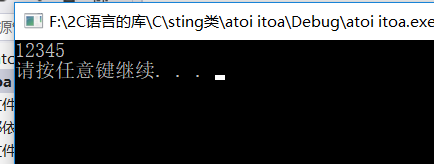atoi()及itoa()的用法
一.itoa()的用法
1.原型:char itoa(int value, char string, int radix)
2.头文件:include<stdlib.h>
3.功能:将整数value转换成字符串存入string,radix为转换所用基数(分别为 2进制, 8进制, 10进制, 16进制)
4.返回值:转换后的字符串的指针
举例:
void Test1()
{
int a = 12345;
char s[25];
itoa(a, s, 10);
printf("%s", s);
}
结果:发现错误

原因:
新版本的vs对旧有的函数itoa进行了安全检查,所以使用新版本的vs会提示错误,而旧版本的没问题。
解决方法:
- 1、使用新函数 _itoa
- 2、加上宏定义
- #define _CRT_NONSTDC_NO_DEPRECATE
#define _CRT_SECURE_NO_WARNINGS

二.atoi的用法
1.原型:int atoi(const char* nptr)
2.头文件 stdlib.h
3.功能:跳过前面的空格字符,直到遇上数字或正负符号才开始做转换,而再遇到非数字或字符串结束时(’\0’)才结束转换,并将结果返回。
4.返回值:成功返回转换后的数值,失败则返回0.
举例:
void Test()
{
string s("1234");
int c = atoi(s.c_str());//先将string类型转换为char*类型,再通过atoi函数将字符数字转换为整形数字
cout << c << endl;
}
结果:

atoi()函数及itoa()函数的实现
atoi()实现
int my_atoi(const char* str)
{
int cur = 0;
const char* pur = str;
if (*str == '+' || *str == '-')//如果开头是正数或者负数,跳过
str++;
while (*str != '0')
{
if (*str > '9' || *str < '0')//如果出现除字符数字以外的字符,跳出循环
break;
if (*str >= '0' && *str <= '9')
{
cur = cur * 10 + *str - '0';//给cur的最低位加上字符数字
}
str++;
}
if (*pur == '-')//判断字符串的开头是正数还是负数
return cur * -1;
return cur;
}
void Test()
{
char s[] = "12345";
int c = my_atoi(s);
cout << c << endl;
}

itoa()函数实现
简单实现:
char* my_itoa(int n, char str[])
{
int count = n;
int i = 0;
if (count < 0)//如果是负数,转换为正数
{
n = -n;
}
while (n > 0)
{
str[i++] = n % 10 + '0';//+‘0’转换为字符数
n /= 10;
}
if (count < 0)
{
str[i++] = '-';
}
str[i] = '\0';
for (int j = i - 1, i = 0; j > i; j--, i++)//由于存入的时候是逆序,现在要反转过来
{
str[j] ^= str[i];
str[i] ^= str[j];
str[j] ^= str[i];
//swap(str[i], str[j]);
}
return str;
}
void Test1()
{
int a = 12345;
char s[25];
char* s1 = my_itoa(123, s);
printf("%s", s1);
}
结果:

考虑进制位
char* my_itoa2(int n,char str[],int radix=10)
{
int i,j,len,sign;
unsigned int tmp;
i = 0;
if(n<0) //
{
tmp = MY_MAX + n + 1;// 这样貌似可以了,按照取反加一的方式进行的
do{
str[i++]=__itoa[tmp%radix]; //取下一个数字
}while((tmp/=radix)>0);//循环相除
}
else
{
do{
str[i++]=__itoa[n%radix]; //取下一个数字
}while((n/=radix)>0);//循环相除
}
str[i]='\0';
len = i;//
for(j=len-1,i=0;j>i;j--,i++) //生成的数字是逆序的,所以要交换
{
swap(str[j], str[i]);
}
return str;
}